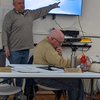Knox to hold hearing on five business districts
Five business districts, circled, will be considered at a Knox hearing on April 11. The areas are: near the intersection of routes 156 and 157; along Route 146 near Township Tavern; on Knox Cave Road near Route 7; near Thacher Park where Thacher Park Road and Ketcham Road intersect; and near the former Cater’s Auction Arena on Route 443.
KNOX — The pattern that has plagued Supervisor Vasilios Lefkaditis since he took office on Jan. 1, 2016 — a town board that consistently voted against him, 4 to 1, on controversial issues — dissolved at this month’s board meeting.
The board voted unanimously to override the Knox Planning Board’s recommendation against creating a business district at the intersection of routes 156 and 157, deciding instead to hold a public hearing that would consider five new business districts in Knox. Lefkaditis has pushed for the business district at 156 and 157 since he took office just over a year ago and was rebuffed twice by a majority of the appointed planning board members.
Lefkaditis has also opposed putting an electrical vehicle charging station in Knox. At the December town board meeting, when the board voted to apply to the state’s Department of Environmental Conservation for a grant to cover the cost of installing an EV station in Knox, Lefkaditis said most townspeople would say, “Screw this; put in a gas pump, overwhelmingly.”
Councilwoman Amy Pokorny followed through, applying for the DEC grant, and receiving $11,835. At the Feb. 14 board meeting, no one on the board would second her motion to accept the grant money.
Some of the three dozen citizens in the gallery — many of them regulars at monthly board meetings since Lefkaditis took office — were derisive of Pokorny, shouting out their disapproval without being checked by anyone on the board.

Business districts
In January, the planning board voted, 6 to 1, to recommend to the town board that a business district not be created at this time at the intersection of routes 156 and 157. Tom Wolfe, Lefkaditis’s rejected choice to chair the planning board, cast the sole dissenting vote.
In November, the planning board had cited “safety, infrastructure, geology and lack of demand” for recommending against creating a business district at routes 156 and 157, urging instead to “focus our efforts and continue to work with the town board and comprehensive planning process to explore potential business districts in town.”
In January, recommendations drafted by Travis O’Donnell and others on the planning board named two other factors that influenced the board’s decision: “input from a rural planning consultant who is working with the town to update its comprehensive plan” and “the need for greater public feedback through public information meetings.”
Wolfe had consistently argued for public feedback, pointing out it should have happened before, rather than after, the planning board made its recommendation to the town board — as required by the town’s comprehensive plan.
Faced with the planning board’s recommendation, the town board had three choices: It could have accepted the recommendation, dropping the proposal; it could have sent it back to the planning board yet again or sent the planning board a similar proposal, such as for a district that mixed residential and business uses; or it could override the recommendation and schedule a public hearing.
It unanimously chose the latter.
John Dorfman, the town’s attorney, instructed the board that it had “to set forth a reason” for overriding the planning board’s recommendation.
“Based on the language in the current comprehensive plan and results of a town-wide survey in 2014,” said Lefkaditis, naming the reasons.
The 2014 survey had been conducted as part of an ongoing process to update the town’s 1995 comprehensive plan.
O’Donnell told Lefkaditis that one in five residents supported a business district there while four out of five didn’t, according to raw data from the survey
Lefkaditis presented a different analysis in which “option D,” for business anywhere in the town of Knox should have been included as favoring that district. Both men agreed the question was poorly constructed.
“There is still support for business in town, not just as overwhelming as you’re saying,” said Pokorny who heads the committee that is updating the master plan.
“They want to live in a rural area, too,” said Councilman Earl Barcomb of Knox residents.
“They’re a perfect marriage,” said Lefkaditis of business and a rural area, “and we can do that.” He cited the examples of Schoharie and Middleburg.
“That’s why the board’s original intent was to keep it in the hamlet,” Barcomb said of businesses. Schoharie and Middleburgh both have walkable business districts with tightly clustered businesses surrounded by open rural land; they are also further from suburban and urban centers than the Hilltowns.
“It’s about building consensus in town,” said Knox resident Ernest Cupernall from the gallery. “First find out what people want, then work together to create the atmosphere to draw businesses.”
Just because people in town want a gas station, it doesn’t mean a company will invest in one, said a resident after which Lefkaditis confirmed he had contacted gas-station companies and no one was interested in opening one in Knox.
Bruce Countryman pointed out from the gallery that, even if a gas station were to open in Knox, residents might buy their gas off the Hill where it’s cheaper.
Earlier in the discussion, Lefkaditis had named the businesses currently near the junction of routes 156 and 157: a furniture maker, a plant nursery, a woodshop, a storage facility, a commercial solar array, and a now-closed restaurant. “It’s already there,” he said of the business district.
“If it’s there already, why do we need a business district?” asked Councilman Dennis Barber.
Lefkaditis responded that the now-closed Highlands Restaurant was over the six-month limit to re-open.
Barcomb noted that special-use permits had been given before. He went on to say that residents who lived in the proposed district didn’t want it.
Lefkaditis responded that the residents were “cherry picked.” The crowd jeered on hearing one of the residents was Michael Hammond, the long-time former supervisor, ousted by Lefkaditis, who lives in the district and runs a woodshop from his home.
In 2014, the town board had voted to create a business district in the hamlet of Knox where, decades ago, businesses flourished but have floundered in recent years. The only new businesses on the horizon in Knox are those that may eventually occupy the building in the hamlet that was once a general store and that since has been rebuilt by Lefkaditis as a personal investment.
“We have a business district at a dead halt,” commented Dee Woessner, a member of the Knox Conservation Advisory Council.
“The nerve!” responded Anna Lefkaditis, the supervisor’s wife, from the gallery. “You moved here two years ago.”
She asked Woessner why she didn’t finish the converted general-store project in the hamlet.
“I’ve got six figures into that building,” said Supervisor Lefkaditis later.
O’Donnell suggested the hearing be broadened to include the other potential business districts named in the master plan.
Initially, Lefkaditis responded, “We’d bite off more than we can chew.”
Lefkaditis described his idea of governance: “If 3,000 people,” he said, approximating the population of Knox, “told me they wanted nuclear power plants, we’d do it...I’m a mouthpiece.”
Cupernall said, “I would think people want amenities...Some backwater place ain’t gonna cut it,” he said, asking, “How much traffic is there on [Route] 146?”
“You set the table and let entrepreneurial spirit grow,” said Lefkaditis, telling a tale about Steve Jobs. He said Jobs, in his youth, would work on computers in the family’s garage as his father asked, “Who’s going to buy computers?” Jobs went on to co-found Apple.
“We may not want industrial business...or a strip club,” said Barcomb. “The type of businesses we want is very much a part of planning.”
In the end, the board agreed unanimously to hold a hearing on April 11, to consider establishing a business district in any or all of these places, as specified in the comprehensive plan:
— The area near the intersection of routes 156 and 157;
— The area along Route 146 near Township Tavern;
— The area on Knox Cave Road near Route 7;
— The area near Thacher Park where Thacher Park Road and Ketcham Road intersect; and
— The area near the former Cater’s Auction Arena on Route 443.
“Will the town board identify which tax parcels will be targeted?” asked O’Donnell.
“Normally, the planning board would do it but we don’t have that,” responded Lefkaditis. “We’re kind of flying in the dark.”

Grant rejected
Pokorny told the town board that Knox needs to complete four “action items” to be eligible to apply for a $100,000 grant from the New York State Energy Research and Development Authority. Knox has completed three of 10 possible items, and Pokorny presented the electric-vehicle charging station as the best option after reading through a list of the other possibilities.
Pokorny, working with a committee, applied for and received an $11,835 grant from the state’s Department of Environmental Conservation to pay for a station that would charge two cars. The town would be required to come up with a 20-percent match, which could include in-kind labor.
Pokorny recommended that highway workers readying the site for the EV station could be the in-kind labor. Pokorny told the board of accepting the DEC grant, “This is an option we could take control of in terms of scheduling.”
The grants are being administered through the state’s 10 economic development zones. A spokesman for the Clean Energy Communities Program explained the process for The Enterprise. There are two tiers — for municipalities with a population under 40,000 like Knox, and for municipalities of 40,000 and above. The grants are awarded on a first come, first served basis; in other words, whichever municipality completes the required action items first will win the grant.
For the Capital District Region, in which Knox is competing, the first four municipalities under 40,000 to complete the action items will receive $100,000 for projects that reduce greenhouse gasses or generate energy from a renewable source. The subsequent 10 municipalities will receive $50,000.
“It’s a race,” Pokorny told the Knox board, “and we’re out in front.”
She also said, “They’re trying to spur competition to get municipalities to do these things.”
The program started last September and will conclude on Sept. 30, 2019, or when the funds have all been used.
Knox already has these three action items to its credit:
— It has made it town policy to benchmark energy use by town-owned buildings;
— It has adopted a unified solar permit to streamline the approval process for residential solar installations; and
— Solarize sessions held two years in a row at the Knox Town Hall have resulted in at least 10 rooftop installations in town as well as contracts for community solar.
Knox is in the process of achieving two other action items: training its building inspector, which is dependent on the timing of projects, and converting at least half of its streetlights to LED, or light emitting diode.
The day after the meeting, Lefkaditis called The Enterprise to say he had made a “Hail Mary pass” and heard back from Joe Pallone with National Grid to which the town had applied for LED lighting. Pallone wrote in a Feb. 15 email to Lefkaditis that the “calculation will be done soon and I’ll send you something regarding it.” He also wrote he would send a “non-disclosure agreement regarding the installation of the LEDs, and then we’ll have the process moving along.”
According to a draft of Pokorny’s proposal on how to spend the $100,000 NYSERDA grant, which The Enterprise reviewed this week, the top priority is to upgrade the 1963 steel-framed highway garage, followed by upgrading the parks maintenance building, and installing LED lights and solar panels.
The first comment Lefkaditis made, after hearing Pokorny’s proposal, was to address the highway superintendent, Gary Salisbury, about the difficulty of having the highway crew do the work to install the EV charging station. “Gary, you have a grader that’s down,” said Lefkaditis.
“Would that take you away from the roads?” Lefkaditis asked Salisbury of the EV project.
“Roads are the priority,” said Salisbury.
“Yeah, I totaled my truck,” said Lefkaditis who lives on a dirt road damaged by winter weather.
“Another option would be to pay...to do the trenching,” said Pokorny, noting there was additional grant money available.
Woessner, in the gallery, read from an Enterprise article quoting Lefkaditis on the desperate need to upgrade the highway garage.
“Are you going to spend the money on a building that could be torn down?” countered Lefkaditis.
Many more comments came from the crowd than from board members.
“To jump through hoops just to apply, that’s nuts,” said Amy Anderson.
“You people who want electric power, pay for your own,” said David Shafer.
Pokorny explained, as she has several times before, that the few people in town who own electric cars, like herself and her husband, charge them at home; the Pokornys use solar panels. The idea, she said, is to attract visitors to Knox. Shafer railed on about the hoax of climate change. “The ozone hole is closed,” he said.
Someone in the crowd demanded to know who was on the committee. As Pokorny named the volunteer members, Lefkaditis said, “I didn’t know you created a committee.”
Lefkaditis went on to read a letter, which board members already had copies of, deriding the idea of an EV station for Knox. The letter, similar to one printed earlier in The Enterprise, was by Josh Von Haugg, a Knox native, now away at college. The crowd broke into applause.
Some in the crowd shouted derisive comments about Pokorny and her initiative.
John Dorfman, the long-time town attorney, himself frequently an object of scorn at board meetings, spoke up for Pokorny and her right as an elected leader to pursue grants for the town.
“The superintendent of the town is the chief financial officer,” said Dorfman. “He has no greater power than any other board member….Individuals on the board have the right, even the obligation to go forward.”
Dorfman noted that the grant money wasn’t coming out of pocket from the town.
“We don’t want it!” shouted someone in the crowd.
“They work for us!” shouted someone else, presumably referring to elected board members.
“This doesn’t benefit the town at all; all we do is pay for it,” said Lefkaditis.
He was referring to a $500 annual charge for software after the first two years that would allow for billing of electric-car customers using the EV station so that the town wouldn’t be paying for the electricity.
“Can I go to the town garage for free fuel?” asked Lefkaditis.
“This is a competitive opportunity,” concluded Pokorny. “If we do our charging station, we’re better positioned to get it done,” she said of obtaining the $100,000 grant.
She also noted there was no risk. If the EV station isn’t used, she said, “We have an asset we own; we can dismantle and sell.”
In the end, no one seconded her motion.



